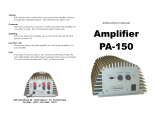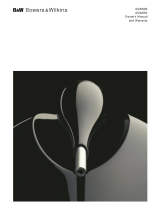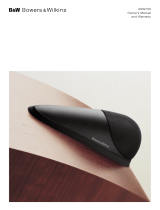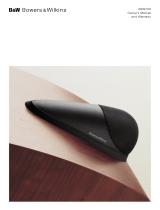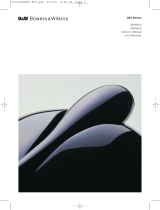Page is loading ...

V-850
V-851
Miller & Kreisel Sound, Inc.
9351 Deering Avenue
Chatsworth, CA 91311-5858 USA
(818) 701-7010 fax (818) 701-0369
www.mksound.com
©2002 Miller & Kreisel Sound, Inc.
powered subwoofer
operation manual
TM

Please record the following information for your records:
Serial Number:
Date of Purchase:
Dealer Name:
Dealer Address:
City/State/Zip:
Country:
Invoice Number:
POWERED SUBWOOFER
TABLE OF CONTENTS
1. SAFETY INSTRUCTIONS...............................................................................................3
2. INTRODUCTION.............................................................................................................4
3. WHERE TO LOCATE YOUR SUBWOOFER................................................................4
4. SUBWOOFER HOOK-UP...............................................................................................5
WIRING WITH THE RCA JACK INPUTS...........................................................5
USING SPEAKER WIRE CONNECTIONS.........................................................6
SATELLITE SPEAKER WIRING OPTIONS.................................................7
PLUGGING IN THE SUBWOOFER...................................................................7
5. SATELLITE/SUBWOOFER PHASING TEST.................................................................8
6. USE OF THE "LOW PASS FILTER" CONTROL.........................................................8
7. USE OF THE "BYPASS" SWITCH.................................................................................8
8. USING MULTIPLE SUBWOOFERS...............................................................................8
9. HOME THEATRE USAGE............................................................................................9
CONNECTING TO A SURROUND SOUND RECEIVER OR PROCESSOR.....9
10. TROUBLESHOOTING...............................................................................................10
11. IF YOU NEED SERVICE..............................................................................................11
12. M&K 10 YEAR / 5 YEAR WARRANTY...........................................................................11
13. CABINET MAINTENANCE............................................................................................11
14. SPECIFICATIONS........................................................................................................11
FIGURE 1 CONNECTING TO A SURROUND PROCESSOR.............................................5
FIGURE 2 CONNECTING TO A STEREO AMP OR PREAMP WITH THE BMC-MINI........6
FIGURE 3 TO AN AMP OR RECEIVER USING SPEAKER WIRES................................6
FIGURE 4 SATELLITE SPEAKER WIRING (OPTIONAL)................................................7
FIGURE 5 WIRING MULTIPLE SUBWOOFERS WITH THE RM-1.....................................9

POWERED SUBWOOFER
1. SAFETY INSTRUCTIONS
1. READ INSTRUCTIONS - All safety and operating instructions should be read before this product is operated.
2. RETAIN INSTRUCTIONS - The safety and operating instructions should be retained for future reference.
3. HEED WARNINGS - All warnings on this product and in the operating instructions should be adhered to.
4. FOLLOW INSTRUCTIONS - All operating and use instructions should be followed.
5. ATTACHMENTS - Do not use attachments not recommended by the product manufacturer as they may cause hazards.
6. WATER & MOISTURE - Do not use this product near water - for example, near a bathtub, washbowl, kitchen sink, or laundry
tub; in a wet basement; or near a swimming pool; and the like.
7. ACCESSORIES - Do not place this product on an unstable cart, stand, tripod, bracket, or table. The product may fall, causing
serious injury to a child or adult, and serious damage to the product. Use only with accessories recommended by the
manufacturer, or sold with the product. Any mounting of the product should follow the manufacturer's instructions and should
use a mounting accessory recommended by the manufacturer.
8. POWER SOURCE - This product should be operated only from the type of power source indicated on the marking label. If you
are unsure of the type of power supply to your home, consult your product dealer or local power company.
9. OVERLOAD - Do not overload wall outlets or extension cords as this can result in a risk of fire or electric shock.
10. LIQUID ENTRY - Never spill any liquid of any kind on the product.
11. SERVICING - Do not attempt to service this product yourself. Opening or removing covers, including any over bottom or
side speaker drivers, may expose you to dangerous voltage or other hazards. Refer all service to qualified service personnel.
12. DAMAGE REQUIRING SERVICE - Unplug this product from the wall outlet and refer servicing to qualified personnel under the
following conditions:
•When the power-supply cord or plug is damaged.
•If liquid has been spilled, or objects have fallen into this product.
•If the product does not operate normally by following the operating instructions. Adjust only controls that are covered by the
operating instructions as an improper adjustment of other controls may result in damage and will often require extensive work by
a qualified technician to restore the product to its normal operation.
•If the product has been dropped or damaged in any way.
•When the product exhibits a distinct change in performance - this indicates a need for service.
13. REPLACEMENT PARTS - When replacement parts are required be sure the service technician has used replacement parts
specified by the manufacturer or have the same characteristics as the original part. Unauthorized substitutions may result in risk
of fire, electric shock, or other hazard.
14. SAFETY CHECK - Upon completion of any service or repairs to this product, ask the service technician to perform safety checks
to determine that the product is in proper operating condition.
15. HEAT - This product should be situated away from heat sources such as radiators, heat registers, stoves, or other products
(including amplifiers) that produce heat.
The exclamation point within an
equilateral triangle is intended to
alert the user of the presence of
important operating and mainte-
nance (servicing) instructions in
the literature accompanying the
appliance.
CAUTION:
TO PREVENT THE RISK OF ELECTRIC SHOCK,
DO NOT REMOVE COVER (OR BACK). NO USER-
SERVICEABLE PARTS INSIDE. REFER SERVIC-
ING TO QUALIFIED SERVICE PERSONNEL.
The lightning flash with arrowhead,
within an equilateral triangle, is
intended to alert the user of the
presence of uninsulated “dangerous
voltage” within the product's enclo-
sure that may be of sufficient magni-
tude to constitute a risk of electric
shock to persons.
3

2. INTRODUCTION
Congratulations! You have just made perhaps the most exciting and dramatic addition that you could make to your audio
or multichannel audio/video system. The new dimension of deep and powerful bass provided by your M&K Deep Bass Powered
Subwoofer will thrill and excite you.
We encourage you to read this owner's manual, as there is a great deal of information provided here to help you get the
best possible performance. This manual gives you basic hook-up instructions first, followed by more detailed technical,
installation, and service information.
If you have any questions about your subwoofer, please contact your M&K dealer, or call us directly at (818) 701-7010,
from 8:30 AM to 5:00 PM Pacific Time. Or you may send an e-mail to suppor
[email protected]. We will be more than happy to
help you with any question. You can also access our web site at: www.mksound.com.
3. WHERE TO LOCATE YOUR SUBWOOFER
M&K subwoofers perform well in most room locations. Unless your ear is a foot or two away from the subwoofer, you will
hear the deep bass coming exclusively from your satellite (or main) speakers. There is no need to place your subwoofer
in-between the satellite speakers.
The ideal place for the subwoofer is the corner with the best structural strength. If the corners are roughly equal in
construction, use the corner nearest the listening position. If the listening position is in the front half of the room, place the
subwoofer in a front corner. If the listening position is in the back of the room, place the subwoofer in a back corner.
If possible, avoid corners near doorways or openings.
Feel free to experiment with the orientation of the subwoofer cabinet. Sometimes the best sound results from aiming the
subwoofer's front driver directly into the wall (1" to 2" from the wall itself).
Another option to find the best location for the subwoofer is to place the subwoofer at the listening position and walk around
the room. Stand in and near each corner. The location where you hear the tightest bass with the most impact is probably the
best location in the room for the subwoofer.
If you are using multiple subwoofers, place them in the same location. Stacking is best, but you can also put them side by
side.
Alternately, you can put multiple subwoofers in different locations. This is appropriate when you have limited choices in
locating the subwoofer and none of the available locations work well. Try to place multiple subwoofers at equal distances from
the listening position to avoid phase cancellation.
Ultimately, the amount and quality of bass you get in your room are dependent on the room itself. Low frequency bass
sounds are affected most by the size of the room and the method of construction used to build it. All rooms are different when
it comes to reproducing bass, and in any given room, bass quantity and quality changes when the subwoofer is moved from
one location to another.
A simple rule to remember is that you get more bass when you move the subwoofer towards any wall or corner. Moving it
away from a wall or corner gives you less bass. Remember that the floor also loads the subwoofer, and that maximum bass is
found with the woofer on the floor in a corner.
In some rooms, a corner location may excite resonance modes, resulting in a muddy or boomy sound. In these rooms, a
more central location along a wall, away from the corner, may give better results. If you experiment, try to find a spot where no
bass notes seem to overpower others and the overall sound is powerful and clean. The goal is to achieve a smooth sound
quality, with the entire bass spectrum equally prominent. In most rooms, this is directly in the corner, not the center of the room.
Because the subwoofer generates a great deal of energy, its output may vibrate objects close to it. If you hear such
vibration, you may need to damp the vibration of nearby objects.
One subwoofer is sufficient in a stereo system because of the nature of human hearing. The ear-brain hearing system is
unable to locate the direction of bass sounds below approximately 100 - 150 Hz. The direction of low frequency sounds (drums,
basses, etc.) is determined by the higher frequency overtones and harmonics that are reproduced by the satellite speakers.
POWERED SUBWOOFER
4

All M&K powered subwoofers have exceptionally sharp (36 dB/octave) low-pass filters to remove the midbass and
midrange frequencies unwanted in a subwoofer. This makes your M&K subwoofer truly non-directional.
No matter where you put the subwoofer, you must allow room for ventilation of its heatsink and backplate. The subwoofer's
power amplifier is mounted on the backplate, and it generates heat.
1. Leave clearance around the subwoofer's heatsink. Do not cover it with drapes.
2. Do not place the subwoofer near baseboard heaters or forced air heating outlets.
3. Do not use the subwoofer outdoors or in a humid environment.
Do not plug the subwoofer into an AC outlet until all system wiring is complete.
4. SUBWOOFER HOOK-UP
There are two different ways to connect the Subwoofer to your system. One uses speaker wire, and the other uses inter-
connect cable with RCA-type jacks. If your receiver or processor has a SUBWOOFER OUTPUT RCA-type jack, use it. This is
the preferred connection for your M&K subwoofer. If your component does not, skip to "USING SPEAKER WIRE CONNEC-
TIONS" on the next page).
NOTE: Do not use "TAPE OUT" jacks to connect your subwoofer, because these jacks have a fixed output level that does
not change when you adjust the system volume control.
WIRING WITH THE RCA JACK INPUTS
The "INPUT" RCA jacks on the back panel of your Subwoofer allow you to directly connect the Subwoofer to preamp-level
components such as surround sound processors, preamplifiers, integrated amps and receivers with preamp outputs, Electronic
High-Pass filters, crossovers, etc. This will give you better bass quality than using the speaker inputs, because it bypasses your
amp or receiver's amplifier stage.
To connect the Subwoofer in this way, simply run one or a pair of shielded RCA - RCA interconnect cables from the
output jacks on your component to the "INPUT" jacks on the Subwoofer's backplate. See Figure 1. It is not necessary to use
both input jacks on the subwoofer.
USING THE BMC-MINI BASS MANAGEMENT CONTROLLER
The M&K BMC-MINI bass management controller can improve the performance of any system that allows for separation
of its preamp and power amp stages by filtering the bass signal fed to the main amplifier and Satellite speakers.This is not
necessary with home theater components that have built-in crossovers.
To use the BMC-MINI with an integrated amp or receiver, the amp or receiver MUST have back panel RCA jacks labelled
Preamp/Main Output AND Power Amp/Main Input. There may be a switch or jumper connections between them. Do not run
POWERED SUBWOOFER
5
100
9351 Deering Avenue, Chatsworth, CA 91311 818-701-7010 www.mksound.com
MILLER & KREISEL SOUND CORPORATION
RIGHT
INPUT
LOW PASS FILTER
(Hz)
FROM AMPLIFIER
50
75
60
125
T
2 AMP
120 VAC 50/60 Hz
RIGHT LEFT
LEFT/MONO
SLOW-BLOW
ATTENTION:
DEBRANCHER AVANT DE
REMPLACER LE FUSIBLE.
UTILIZER UN FUSIBLE
DE RECHANGE DE MEME TYPE.
CAUTION:
DISCONNECT SUPPLY CORD
BEFORE CHANGING FUSE.
REPLACE FUSE ONLY
WITH SAME TYPE.
CAUTION
RISK OF ELECTRIC SHOCK
DO NOT OPEN
AVIS:
RISQUE DE CHOC ELECTRIQUE. NE PAS OUVRIR.
BASS LEVEL
+3 dB
+6 dB
- 3 dB
- 6 dB
REFERENCE
+9 dB
BYPASS
VARIABLE
!
SURROUND PROCESSOR OR RECEIVER
SUB / MONO OUT
FIGURE 1 - CONNECTING TO A SURROUND PROCESSOR

your system with multiple filters. If your receiver or controller is THX-certified or Dolby Digital AC-3 capable, you do not need
the BMC-MINI. All Dolby Digital AC-3 and THX certified controllers and receivers have the proper high and low-pass filters built
in. See Figure 2 below.
This filter will give you greater dynamic range, lower distortion, and an increased maximum output level. If you have any
questions about using them, please contact your dealer or M&K.
For wiring, see the BMC-Mini owner's manual.
USING SPEAKER WIRE CONNECTIONS
Some M&K subwoofer owners hook up their subwoofer by connecting it to their receiver or amplifier using speaker wires.
To do so, you make the same kind of connections that you would use for your satellite (or main) speakers, except that both the
left and right channels go to the subwoofer. (If you are using two subwoofers, connect one channel only to each subwoofer).
1. Run speaker wire between the Amplifier's Left channel output terminals and the Subwoofer's Left channel
"FROM AMPLIFIER" terminals.
a. Connect the Amplifier's Left channel Positive (+) terminal and the Subwoofer's Left RED (+) "FROM
AMPLIFIER" terminal.
b. Connect the Amplifier's Left channel Negative (—) terminal and the Subwoofer's Left BLACK (—)
"FROM AMPLIFIER" terminal.
2. Make matching connections for the Right channel. See Figure 3.
POWERED SUBWOOFER
6
100
9351 Deering Avenue, Chatsworth, CA 91311 818/701-7010 www.mksound.com
MILLER & KREISEL SOUND CORPORATION
RIGHT
INPUT
LOW PASS FILTER
(Hz)
FROM AMPLIFIER
50
75
60
125
T
2 AMP
120 VAC 50/60 Hz
RIGHT LEFT
LEFT/MONO
SLOW-BLOW
ATTENTION:
DEBRANCHER AVANT DE
REMPLACER LE FUSIBLE.
UTILIZER UN FUSIBLE
DE RECHANGE DE MEME TYPE.
CAUTION:
DISCONNECT SUPPLY CORD
BEFORE CHANGING FUSE.
REPLACE FUSE ONLY
WITH SAME TYPE.
CAUTION
RISK OF ELECTRIC SHOCK
DO NOT OPEN
AVIS:
RISQUE DE CHOC ELECTRIQUE. NE PAS OUVRIR.
BASS LEVEL
+3 dB
+6 dB
- 3 dB
- 6 dB
REFERENCE
+9 dB
BYPASS
VARIABLE
!
+
+
+
+
AMPLIFIER OR RECEIVER
Stereo preamp or processor
BMC-Mini Bass
Management Controller
Power amplifier
M&K powered subwoofer
FIGURE 2 - CONNECTING TO A STEREO AMP OR PREAMP WITH THE BMC-MINI (OPTIONAL)
FIGURE 3 - TO AN AMP OR RECEIVER USING SPEAKER WIRES

IMPORTANT NOTE FOR DOLBY SURROUND SYSTEMS: (Excluding Dolby Digital AC-3)
When the subwoofer is connected to the Left and Right amplifier outputs, the Center channel WIDE/NORMAL switch MUST
be set to the NORMAL mode. If the switch is set to the WIDE mode, the bass content of the Center channel will not be fed to
the subwoofer, and a significant amount of bass in the program material will not be reproduced.
FIGURE 4 - SATELLITE SPEAKER WIRING (OPTIONAL)
SATELLITE SPEAKER WIRING OPTIONS
If you use speaker wires to connect the subwoofer, you have two options for the satellite speakers.
1. Connect both the satellite speakers and the subwoofer direct to your amp or receiver, with one set of wires running to
the satellites and another set to the subwoofer. See Figure 4.
2. For convenience, you can also connect the satellite speakers to the subwoofer. Both sets of wires will be connected
to the same terminals on the subwoofer. Connect both the Amplifier's Left channel Positive (+) terminal and the Left satellite's
Positive (+) terminal to the subwoofer Left RED (+) "FROM AMPLIFIER" terminal. Also connect both the Amplifier's Left
channel Negative ( — ) terminal and the Left satellite's Negative ( — )terminal to the subwoofer's Left BLACK ( — ) "FROM
AMPLIFIER" terminal. Make matching connections for the Right channel.
If your Amplifier has two sets of speaker outputs (e.g., A and B), you can connect the satellites to one set and the
subwoofer to the other. But if you get weak or no output when you connect your speaker this way, connect both sets of
speaker wires to the same output terminals.
PLUGGING IN THE SUBWOOFER
Once all the speaker wires or preamp interconnect cables are in place, you are ready to plug in the subwoofer. Set the
"BASS LEVEL" control to "MIN". Then plug the AC cord in. You should hear a thump from the subwoofer. This is the normal
sound of its power supply charging and discharging when it is plugged in and unplugged.
Once your system wiring is complete and the subwoofer is plugged into the wall, leave it plugged in, even when the
system is turned off. The normal mode of operation for the subwoofer is to remain plugged in 24 hours a day. Among other
things, this means that you don't have to walk over to the subwoofer to turn it on every time you want to use the system.
If you decide to plug the subwoofer into a switched outlet on another component, that outlet must have the following
minimum power rating of 300 watts.
Now, play some music through your system to make sure that the Satellite speakers are working properly. If they are,
carefully advance the "BASS LEVEL" control. The Subwoofer should begin to play. Set the "BASS LEVEL" control where the
Subwoofer sounds in balance with the Satellite speakers. If the system is not working properly, unplug the Subwoofer and
check all of your connections. Call your dealer or the factory if you cannot solve any problem.
POWERED SUBWOOFER
7
100
9351 Deering Avenue, Chatsworth, CA 91311 818/701-7010 www.mksound.com
MILLER & KREISEL SOUND CORPORATION
RIGHT
INPUT
LOW PASS FILTER
(Hz)
FROM AMPLIFIER
50
75
60
125
T
2 AMP
120 VAC 50/60 Hz
RIGHT LEFT
LEFT/MONO
SLOW-BLOW
ATTENTION:
DEBRANCHER AVANT DE
REMPLACER LE FUSIBLE.
UTILIZER UN FUSIBLE
DE RECHANGE DE MEME TYPE.
CAUTION:
DISCONNECT SUPPLY CORD
BEFORE CHANGING FUSE.
REPLACE FUSE ONLY
WITH SAME TYPE.
CAUTION
RISK OF ELECTRIC SHOCK
DO NOT OPEN
AVIS:
RISQUE DE CHOC ELECTRIQUE. NE PAS OUVRIR.
BASS LEVEL
+3 dB
+6 dB
- 3 dB
- 6 dB
REFERENCE
+9 dB
BYPASS
VARIABLE
!
+
+
+
+
AMPLIFIER OR RECEIVER
+
+
RIGHT
LEFT
SATELLITE SPEAKERS

The best way to set the level of the subwoofer is to do it by ear, listening over several hours or days to familiar recordings.
Make adjustments to the level in small increments, depending on whether the bass level sounds too high or too low. Of course,
you can always deliberately set the level higher or lower than flat if you need a higher bass level (especially for cinema or
television sources) or if you don't want to disturb your neighbors.
5. SATELLITE/SUBWOOFER PHASING TEST
You are now almost finished with the basic set-up. But before you can sit down to enjoy your new subwoofer, you need to
perform one simple Phasing Test. This test insures optimum sound in the critical bass frequencies where your subwoofer and
satellite speakers overlap.
Play a familiar CD, LP, or tape with steady, consistent bass. Listen carefully to the mid-bass (70 - 100 Hz) region — the
part of the spectrum where electric or string basses and drums are found. Then, move the "PHASE" switch on the
SUBWOOFER's back panel from either up (+) or down (—) to the opposite position.
Now listen to the same musical passage, concentrating on the mid-bass region. If you hear less bass, the original
connections were correct. If you hear more bass, the new connections are correct. If you have two subwoofers, perform one
test for each subwoofer. When you perform each test, make sure the other subwoofer is not operating by either unplugging its
input cable or its power cord.
Another method of setting phase uses a pink noise source and a spectrum analyzer. If you have these, place the
microphone at the main listening position and look at its display in the mid-bass region of 70 - 100 Hz. The wiring/ switch
position showing the most output in that region has the correct phase.
You need to perform this test because when satellite speakers are located separate from a subwoofer, each speaker is at
a different distance from your ear. In some cases, the difference will be just enough so that the output from the subwoofer
arrives out of phase with the output of the satellites. When this happens, that critical mid-bass is actually cancelled. You should
re-do this test any time you move your speakers.
If you want to experiment further, you can move the satellite speakers either towards or away from your listening position,
making changes in small increments. This will focus the system's sound to its optimum. When you hear the best balance
between stereo image localization and maximum impact and output in the mid-bass, you have the ideal location.
6. USE OF THE "LOW PASS FILTER" CONTROL
The back panel control "LOW PASS FILTER" sets the upper rolloff point of the subwoofer, eliminating mid-bass and
midrange that are being reproduced by your satellite speakers. The control is a means of fine-tuning the transition between
your subwoofer and satellite speakers, and it provides a rolloff of 12 dB/octave up to 125 Hz, where the filter shifts to 36
dB/octave. In most systems, including M&K satellites, 85 Hz gives the best blend. If you don't want to experiment, set the
control at 85 Hz.
The goal is to get a balanced acoustic output in your room. This is not necessarily the same as flat electrical output.
Rooms typically reinforce bass frequencies around 100 Hz, so by leaving an electrical gap, you may actually get a smooth
acoustical response where it matters, in the room.
Think of this control as a mid-bass fine tuning adjustment that you set to achieve the best transition between the satellite
speakers and the subwoofer. When you hear a smooth sound overall, well balanced between the deep bass and the rest of
the audible spectrum, the control is set properly.
7. USE OF THE "BYPASS" SWITCH
(Recommended with Dolby Digital & THX components)
If you have a THX, Dolby Digital, or DTS component with a built-in Low-Pass filter as part of its subwoofer output, or if you
are using a separate Electronic Crossover, set the “VARIABLE” / “BYPASS” switch on the back of the subwoofer to “BYPASS”
position. This bypasses the internal low-pass filter so that there is no interaction between the subwoofer’s filter and your
component’s filter. If you have any questions regarding the filters, please contact your M&K dealer or the M&K factory.
8. USING MULTIPLE SUBWOOFERS
Using two (or more) subwoofers in your system gives you the ultimate in bass performance. You'll hear improved impact
and definition, as well as greater output and dynamic range. See Section 4 on page 5 for more information.
POWERED SUBWOOFER
8

If multiple subwoofers are used, try to place them in the same location. Stacking is best, but you can also put them side
by side. Alternately, you can put multiple subwoofers in different locations, at adjacent corners. This is appropriate when you
have limited choices in locating the subwoofer and none of the available locations work well. Try to place multiple subwoofers
at equal distances from the listening position to avoid phase cancellation.
Wiring with two subwoofers is simple. By using M&K’s RM-1 Subwoofer Controller, see figure 5, simply run one cable from
the sub/mono on the LFE or subwoofer output on the processor/receiver to the RM-1’s input terminal. From the RM-1’s output
terminal, run the proper cable to the input terminal marked “LEFT/MONO” on the subwoofer. Use the calibration control knob
on the RM-1 to control the output level of all your subwoofers.
FIGURE 5 - WIRING MULTIPLE SUBWOOFERS WITH THE RM-1
9. HOME THEATRE USAGE
Compared to music sources, in some cases, you may prefer the subwoofer set to a higher playback level for video sources.
This may occur when video sources (especially older films and some television) have very little deep bass present. You may
also want to exaggerate the effect to make spectacular video sources even more impressive!
If you are using your Subwoofer in a multichannel Home Theatre system, make sure you are using the Subwoofer Output
jack to connect your subwoofer.
CONNECTING THE SUBWOOFER TO A SURROUND SOUND RECEIVER OR PROCESSOR:
The preferred connection from a surround sound amp or controller is from a SUBWOOFER OUTPUT (or MONO) RCA
jack. This connection insures that a full bass signal is fed to the subwoofer. If your component doesn't have a subwoofer
output jack, connect the Subwoofer to the front Left and Right channel speaker outputs (do not use the Center channel
speaker output).
IF YOU ARE CONNECTING YOUR SUBWOOFER TO AMPLIFIER OUTPUTS: When the subwoofer is connected to the
Left and Right amplifier outputs using speaker wires, the Center channel WIDE/NORMAL switch MUST be set to the NORMAL
mode. If the switch is set to the WIDE mode, the bass content of the Center channel will not be fed to the subwoofer, and a
significant amount of the bass in the material you are listening to will be lost.
POWERED SUBWOOFER
9
SUB 1
SUB 2
INPUT
RM-1
SUBWOOFER
CONTROLLER
100
PHASE
9351 Deering Avenue, Chatsworth, CA 91311 818/701-7010 www.mksound.com
MILLER & KREISEL SOUND CORPORATION
RIGHT
INPUT
LOW PASS FILTER
(Hz)
FROM AMPLIFIER
50
75
60
125
T
2 AMP
120 VAC 50/60 Hz
RIGHT LEFT
LEFT/MONO
SLOW-BLOW
ATTENTION:
DEBRANCHER AVANT DE
REMPLACER LE FUSIBLE.
UTILIZER UN FUSIBLE
DE RECHANGE DE MEME TYPE.
CAUTION:
DISCONNECT SUPPLY CORD
BEFORE CHANGING FUSE.
REPLACE FUSE ONLY
WITH SAME TYPE.
CAUTION
RISK OF ELECTRIC SHOCK
DO NOT OPEN
AVI S:
RISQUE DE CHOC ELECTRIQUE. NE PAS OUVRIR.
+
-
BASS LEVEL
+3 dB
+6 dB
- 3 dB
- 6 dB
REFERENCE
+9 dB
BYPASS
VARIABLE
!
100
PHASE
9351 Deering Avenue, Chatsworth, CA 91311 818/701-7010 www.mksound.com
MILLER & KREISEL SOUND CORPORATION
RIGHT
INPUT
LOW PASS FILTER
(Hz)
FROM AMPLIFIER
50
75
60
125
T
2 AMP
120 VAC 50/60 Hz
RIGHT LEFT
LEFT/MONO
SLOW-BLOW
ATTENTION:
DEBRANCHER AVANT DE
REMPLACER LE FUSIBLE.
UTILIZER UN FUSIBLE
DE RECHANGE DE MEME TYPE.
CAUTION:
DISCONNECT SUPPLY CORD
BEFORE CHANGING FUSE.
REPLACE FUSE ONLY
WITH SAME TYPE.
CAUTION
RISK OF ELECTRIC SHOCK
DO NOT OPEN
AVIS:
RISQUE DE CHOC ELECTRIQUE. NE PAS OUVRIR.
+
-
BASS LEVEL
+3 dB
+6 dB
- 3 dB
- 6 dB
REFERENCE
+9 dB
BYPASS
VARIABLE
!
SURROUND PROCESSOR OR RECEIVER
SUB / MONO OUT
RM-1 Subwoofer Controller

11. TROUBLESHOOTING
Your M&K Subwoofer amplifier circuit provides high reliability, and, if necessary, easy modular replacement of parts. This
guide will help you to solve or diagnose most problems that can occur with your Subwoofer. In the event that a fuse blows, you
must replace it with a fuse of the correct value to avoid a fire hazard and to maintain your warranty protection.
1. If your Subwoofer has no output:
a. Make sure that the Subwoofer is plugged into an AC outlet.
b. Check the "BASS LEVEL" control and make sure that it is set above the "MIN" position. Rotate it
clockwise if it is set to the "MIN" position.
c. Check the red LED on the Subwoofer's back panel. If the LED is not lit, check the AC fuse next to
the LED. Unplug the Subwoofer before changing the fuse. See instructions on Page 12. If the
element inside the fuse is broken, replace the fuse. If it blows again, contact your dealer or M&K.
d. If the red LED is lit, try this test: Turn the "BASS LEVEL" control to "MIN". Plug a standard RCA
cable into the "FROM PREAMP" jacks. Lightly touch the plug at the free end of the cable, while
slowly turning the "BASS LEVEL" control clockwise. If you hear noise from the Subwoofer when you
touch the cable, the Subwoofer is functioning. Look elsewhere in your system for the problem. If
you hear no noise, contact your dealer or M&K.
e. Make sure that the input cables are OK. Double check your connections. If necessary, replace any
defective cables or speaker wires.
2. If, after operating the woofer at high volume levels for a long time, the woofer cuts out or becomes
intermittent:
Your Subwoofer has a protection circuit that protects it from overheating. After hours of continuous operation
at extremely high volume levels, this circuit may kill the power to the Subwoofer. When it activates, the sound
may switch in and out rapidly, with a fluttering sound. If this happens, unplug the unit and let it sit for at least
half an hour. After that time, plug it back in. It should operate normally. If you find this happens frequently,
contact the factory for advice.
3. If you are using the "FROM AMPLIFIER" terminals, and the Subwoofer has very little output:
Make sure that the input cables are in phase. Reverse the (+) and the ( — ) connections for ONE CHANNEL
ONLY at the "FROM AMPLIFIER" terminals. If the problem remains, put the cables back as they were. Then
perform the test in Step 4.
4. If the midbass range (the area of transition between Subwoofer and Satellite speakers) sounds weak:
Refer to Section 5, Phasing Test, on page 8. Reverse the (+) and ( — ) connections at the back of BOTH
Satellite speakers, OR switch the "PHASE" switch from (+) to ( — ) or vice versa. The wiring configuration
that gives the most bass is correct.
5. If you are using the "FROM PREAMP" input terminals, and you hear a thump through the Subwoofer every
time you turn the system on:
Either the preamp, receiver, or surround sound processor is generating the thump, and the Subwoofer is
reproducing it. To eliminate this problem, switch to the speaker wire "FROM AMPLIFIER" input terminals.
6. If you hear a persistent hum or buzz through the Subwoofer:
Because the Subwoofer reproduces the 60 Hz hum frequency, it is often blamed for causing hum that
originates elsewhere in the system. Always avoid running all speaker wires and RCA interconnect cables
near to AC cords and component power supplies.Wires and cables running close to AC lines are a common
source of hum. If necessary, reroute your cables.
To identify the source of hum, remove all input cables to the Subwoofer, but leave it plugged into the AC
outlet. Carefully turn the "BASS LEVEL" control up towards the "MAX" position. If you hear hum coming from
POWERED SUBWOOFER
10

the Subwoofer's speaker driver, the Subwoofer is the source of the hum. If you hear no hum or less hum, the
problem is probably coming from another component.
Hum can also be caused by AC ground loops. If the Subwoofer is plugged into a separate AC outlet, try
plugging it into the same outlet used for your amplifier or receiver, or reverse the polarity of its AC plug.
If these suggestions do not solve your problems, contact your dealer or M&K.
7. If there is an unusual sound coming from the Subwoofer with no music playing:
Try removing the input cables as described in Step 5 above. If the noise disappears, it is coming from
another component. If it does not go away, contact your M&K dealer or the factory.
IF YOU NEED TO REPLACE THE EXTERNAL FUSE:
Disconnect supply cord before changing fuse. Replace fuse only with same type.
Remove the fuse cap. If the fuse cap has an arrow printed on it, push the cap in and turn it counterclockwise. If the fuse
cap has a slot in it, use a flat head screwdriver to turn it counterclockwise. Look carefully at the fuse. If the wire filament inside
the glass is broken, replace the fuse ONLY with one of the identical size and value. USING A FUSE OF A HIGHER VALUE
WILL VOID YOUR WARRANTY AND MAY CREATE A FIRE HAZARD. Plug the Subwoofer back in. If it does not work, unplug
it immediately, and contact your dealer or M&K for service.
11. IF YOU NEED SERVICE
Contact your dealer or M&K. Please have the unit's model and serial numbers (found on the back of the cabinet), date of
purchase, the name of your dealer, and a complete description of the problem. You can call M&K between 8:30 AM and 5:00
PM Pacific Time, Monday through Friday, at (818) 701-7010. If you call outside these hours, leave a message, and we will return
your call. Alternatively, you may send an e-mail to ser
DO NOT RETURN YOUR SPEAKERS TO THE FACTORY FOR
SERVICE WITHOUT OBTAINING PRIOR AUTHORIZATION
12. M&K 10 YEAR / 5 YEAR WARRANTY
All M&K powered subwoofers carry a five year limited parts and labor warranty on the amplifier and power supply, ten year
limited parts and labor warranty on the subwoofer driver. This warranty is transferable to subsequent owners up to five years
from the date of original purchase. It does not cover abuse, misuse, repairs by unauthorized service stations, speakers
without serial numbers, and speakers damaged in shipping or by accident. If you have any questions about the warranty,
please contact M&K.
13. CABINET MAINTENANCE
The painted black cabinet of your subwoofer has a furniture-grade finish that will maintain its attractive appearance with
proper care. Treat it as you would any piece of fine furniture. Regular cleaning is all that is required. Matching black paint can
be used to repair any surface damage.
14. SPECIFICATIONS
V-850 and V-851
POWER OUTPUT: 125 watts RMS
FREQUENCY RESPONSE: 20 Hz - 200 Hz ± 2dB
LOW-PASS FILTER: Variable from 50Hz - 125Hz
MAGNETICALLY SHIELDED: Yes
DIMENSIONS (HxWxD): 18” x 15.25” x 21.25”
WEIGHT: 52 lbs. (V-850)
50 lbs. (V-851)
POWERED SUBWOOFER
11

12
POWERED SUBWOOFER
V-850/V-851 subwoofer manual
PN # 70041
08/20/02 rev.1 pt/qrk
/

